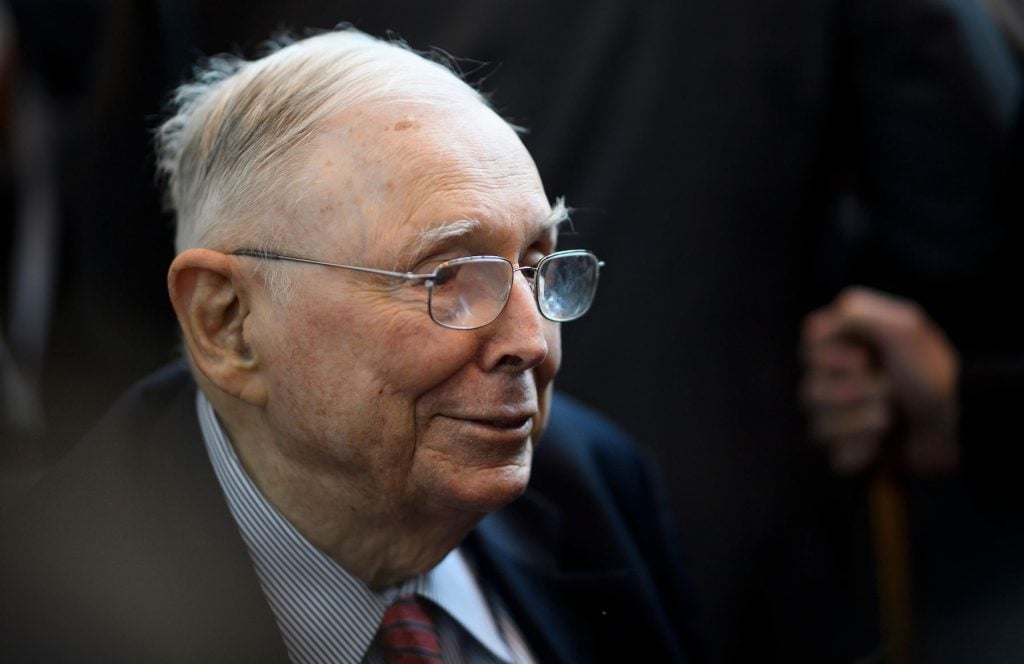Curiosities
Can a Talking Rousseau Save Facebook? Why Does This Billionaire Think He’s Le Corbusier? + Other Questions I Have About This Week’s Art News
Plus, the coin collecting community is upended by a "physical Bitcoin."

Plus, the coin collecting community is upended by a "physical Bitcoin."

Ben Davis

Curiosities is a column where I comment on the art news of the week, sometimes about stories that were too small or strange to make the cut, sometimes just giving my thoughts on the highs and lows.
Below, some questions posed by the events of the last week…

Mark Zuckerberg announcing the new name of the company during a Facebook Connect livestream on October 28, 2021. Photo: Jakub Porzycki/NurPhoto via Getty Images.
You’ve probably seen the ghastly video released on October 28, where dead-eyed Facebook CEO Mark Zuckerberg announces that his company has a new corporate umbrella name, Meta, detailing the whimsical future he hopes to bring us with the corporate “Metaverse.” As he shows it off in the video, this basically amounts to a life-like (or Second Life–like) virtual alternate universe.
As an example of the cool things you might do, Zuckerberg promises that you will be able to meet up with cartoon versions of your friends for poker night in an imagined outer-space club house. Of course, zero gravity doesn’t seem like the best condition in which to play poker in, but nevermind that. The most important thing is that some of your friends may assume the form of wacky cartoon robots. (Click to 0:48 in the video below to see this all play out.)
What I particularly love is the part where Zuck and Friends pause their VR space jam to Facetime their absent friend Naomi, to see why she hasn’t manifested yet in their Meta-hang. “Sorry I’m running late, but you gotta see what we’re checking out,” Naomi tells them. “There’s an artist going around SoHo hiding AR pieces for people!”
She then activates the augmented-reality graffiti she has found, a mandala of snakelike color-forms that bulges from a wall into 3D life. She “shares the link” to it, and it breeches into the space station’s Meta reality. Zuckerberg and friends float around the writhing, elephantine art orb in simulated zero gravity, cooing with simulated wonder.
“3D street art—that’s cool,” Zuckerberg enthuses.
The snake-ball starts to vanish, but Naomi says she’s going to “tip the artist” to keep the fun going. Bold new monetization opportunities for all!
What I think is great here is that the ad chose to name-check SoHo, a NYC neighborhood so touristy and gentrified that it hasn’t symbolized anything like ‘youth’ or ‘cool’ since way before Facebook was born (never forget) as a website to rank the hotness of Harvard girls.
But Facebook’s—erh, sorry, Meta’s—designs on art didn’t end there. In a Tweet on November 4, the rechristened company teased potential fans: “Enter a world of imagination with Meta and explore endless possibilities in 3D.”
This enticement was followed by the rocket ship and paint palette emojis. This is, of course, the universal internet way of symbolizing that they were high on paint fumes when they came up with this idea.
Enter a world of imagination with Meta and explore endless possibilities in 3D. ? ? pic.twitter.com/I7AYtzei78
— Meta (@Meta) November 4, 2021
The attached video shows a group of kids in a museum. Somewhere in the background lurks a series of Hilma af Klint’s mystical paintings—but such boring, static treasures are of no interest to the girl at the center of the clip, who is drawn towards Henri Rousseau’s Fight between a Tiger and a Buffalo (1909) (from the Cleveland Museum), only to see it burst to life.
The tiger (a metaphor for Zuckerberg) looks up from munching the buffalo’s neck (a metaphor for his existing business of extracting data from his billion users). “This is the dimension of imagination,” it burbles.
We are then swept into a fantastical Rousseau-inspired jungle rave of twerking flamingos and capering monkeys, as the kids and animals alike nod along to the beat of Way in My Brain by SL2.
I do love that Zuckerberg is betting his embattled empire’s entire future on the idea, “what if the art… came alive?”, even if it all makes me queasy. Aesthetically, I was merely exasperated by that Facebook street-art video. Drag Henri Rousseau into it, and now my feelings about it are much more intense. Now I am meta-exasperated.
What’s the most valuable rare coin of all time?
Perhaps when I ask this, you think it is the Brasher Doubloon, from 1797, sold for $9.3 million at Heritage Auctions earlier this year?
Or the ultra-rare gold coin featuring an Augustus Saint-Gaudens double eagle, one of just a few minted in 1933, once owned by King Farouk of Egypt, which sold for $18.9 million at Sotheby’s back in June?
If those are your answers, well, congratulations—you’re a numismatic savant. I had to look that up on Wikipedia. But there’s a new coin in town.
In a sign of just how fast things are getting very, very weird, the answer is actually the “Gold Cas,” a privately minted coin that is just 10 short years old, a self-described “physical Bitcoin.”
Let me tell the tale of Casascius: Back in 2011, Utah entrepreneur Mike Caldwell had the inspiration to create a collectible that appealed to both the burgeoning crypto community and to the more old-fashioned community of people who hoard gold bars beneath a booby-trapped panel in their floor.
And so the Casascius Coin was born, a line of collectible gold coins, each with a holographic seal that, when broken, unlocks access to an amount of Bitcoin, minted in 0.1, 0.5, 1, 5, 10, 25, 100, and 1,000 BTC denominations.
GreatCollections.com, a coin auction site, recently put out a press release bragging that one of their clients was in possession of a coveted Gold Cas, which is the name of the ultra-rare 1,000 BTC version. Purchased for $4,905 in 2011, that coin is now worth close to $65 million at today’s Bitcoin prices. Plus you could get $1,800 for the gold!
(The press release is a promo for the upcoming auction of a 25 BTC Casascius on GreatCollections on November 14. Bidding for that coin started at $1, and is currently at $920,000, with 18 bidders—but is likely to go a little higher since the value of 25 BTC alone currently stands at $1.5 million or so.)

A Casascius Bitcoin Gold-Plated Coin. Image courtesy GreatCollections.
You may wonder what happened to the Casascius company. Well, as it turns out, minting physical Bitcoins did not sit well with the Financial Crimes Enforcement Network (FinCEN), and in 2013 the Treasury Department sent Caldwell a letter saying that he was going to have to register as a money transmitter. Just a few months earlier, speaking to the New Yorker, he had expressed confidence that his business was safe, mainly because crypto was such a minor, boutique affair:
Since mining yields pocket change for most, even if it were technically a violation of the way FinCEN sees the law, mining without registering would be like “laundering” a twenty-dollar bill by taking it to the grocery store and asking for two tens… it’s hardly worth the resources for anyone to care about it, no matter how illegal they decide it should be.
What a difference a decade makes, no?

Vice Chairman of Berkshire Hathaway Charlie Munger attends the annual Berkshire shareholders meeting in Omaha, Nebraska, May 3, 2019. Photo: Johannes Eisele/AFP via Getty Images.
The architecture and design worlds have been agog for the last week over the revelation of the design for the new Munger Hall dormitory at the University of California, Santa Barbara. The 11-story, 4,500-room, $1.2 billion “hell dorm” is the product of billionaire Charlie Munger, a colleague of Warren Buffet’s at Berkshire Hathaway and an architecture enthusiast, who made a fat $200 million donation to the school on the condition that he get to design it.
The result is something that critics like the LAT‘s Carolina Miranda have said resembles a prison—although a prison with its own built-in Costco, so you can source giant cans of beans to eat in your single-occupancy room, 94 percent of which have no windows. Instead of actual windows, Munger decided to provide TVs that mimic windows and allow you to pick what time of day you want them to simulate, inspired by an idea from the cheap cabins in Disney cruise ships (incidentally, the rooms also resemble the cells where the henchmen sleep in Squid Game).
In a chest-thumping interview with Architectural Record last week, Munger defended himself, saying that he drew inspiration from Le Corbusier’s 1947–52 Unité d’Habitation in Marseille. Except, he stressed, his dorm would be better, because Le Corbusier’s influential housing block “was too narrow to make the spaces interesting. So the whole thing didn’t work worth shit. I’ve fixed that. We took Corbusier’s errors and the errors in university housing and eliminated them one by one.”
There’s plenty to say about Le Corbusier’s “errors”—like, say, his flirtations with fascism. But as an architect, his opinion on windows was not one of them, inspired as he was by the ordinary person’s need for sun and air circulation, following the pandemics of his era. Said Le Corbusier:
The sun is the master of life….The sun must penetrate every dwelling several hours a day, even during the season when sunlight is most scarce. Society will no longer tolerate a situation where entire families are cut off from the sun and thus doomed to declining health… To introduce the sun is the new and most imperative duty of the architect.
Apparently, some architects agree with Corbu. Dennis McFadden, a consulting architect on the university’s Design Review Committee, quit in protest of the project, saying it is “unsupportable from my perspective as an architect, a parent, and a human being.”